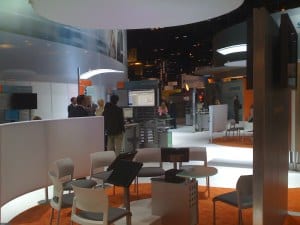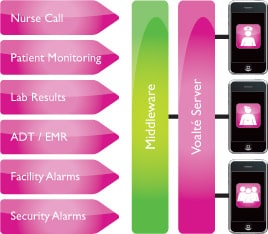 HIMSS’09 had some highlights from various vendor briefings and conversations in the halls that are abstracted below. By no means is this inclusive of all discussions, but reflects what are the gems I walked away with from this event and is certainly in contrast to the previous HIMSS post.
HIMSS’09 had some highlights from various vendor briefings and conversations in the halls that are abstracted below. By no means is this inclusive of all discussions, but reflects what are the gems I walked away with from this event and is certainly in contrast to the previous HIMSS post.
Overview:
HIMSS was well attended, though a number of exhibitors I talked to said visits were down but in so saying also commented that those they did meet with tended to be of “higher quality” (i.e., those who can sign a check).
The Stimulus Bill and how to capitalize on it was something that every EMR vendor was promoting, each with their own interpretation of “meaningful use” and how they, the vendor could assist the prospect in meeting meaningful use criteria. Funny thing is, meaningful use has yet to be defined.
While all EMR vendors were pressuring buyers to place their orders early for demonstrating meaningful use, many CIOs and other hospital executives are concerned that the vendors will not have the staff available to deploy their solutions on site. Vendors stated that they are preparing for this, but I’m not convinced. Also, there is the simple issue that of how does one get the best people on their particular project/deployment. Indeed, that providers who can act quickly may be at a significant advantage to laggards, problem is, where do you find the money in this economy.
CIOs are also concerned as to how they will on-ramp affiliated physicians, e.g., what will it take to get smaller practices to adopt as Stimulus reimbursement may not be enough incentive. Nothing new here. The only way IT is adopted in any sector is if it either saves money or makes money, with preference to the latter. EMR solutions have not had much success in clearly articulating the value, thus low adoption.
 While the Microsoft booth was absolutely hopping during the show, most other large EMR vendors had booths far too large for the amount of attendees visiting them. At some, it looked like the only people in the booth were bored sales people. Clearly there is something wrong with this picture for EMR vendors as one would have thought they would have been equally busy as prospects look to adopt and tap the Stimulus. Instead, attendees appeared to be looking for solutions that will improve operations, regardless of Stimulus. A big exception was AllScripts, they seemed to be busy each time I walked by.
While the Microsoft booth was absolutely hopping during the show, most other large EMR vendors had booths far too large for the amount of attendees visiting them. At some, it looked like the only people in the booth were bored sales people. Clearly there is something wrong with this picture for EMR vendors as one would have thought they would have been equally busy as prospects look to adopt and tap the Stimulus. Instead, attendees appeared to be looking for solutions that will improve operations, regardless of Stimulus. A big exception was AllScripts, they seemed to be busy each time I walked by.
Saw surprising little, truly innovative solutions on display. Seems like the vendors have cut R&D as aggressively as their customers (hospitals) have cut CapEx spending, which according to investment firm Credit Suisse, is currently down 9.9% and is expected to drop 11.2% over the next six months.
HIT Vendor Briefings:
While I met with numerous vendors over the three and a half days of HIMSS, I paid particular attention to HIE/RHIO vendors as I see them as becoming a potentially important part of future consumer-centric healthcare for they are aggregating health data at the local and regional level which later may be served up into one of the Personal Health Clouds, e.g., Google Health, HealthVault or even Dossia.
InterSystems: Company’s strategy is to productize solutions after they see a critical mass of customers doing a particular activity with their product. This strategy led to development of HealthShare, which is the platform being used at Rhode Island’s new RHIO and also for the Long Island RHIO. If memory serves me correctly, this will also be used for the Brooklyn RHIO.
Kryptiq: Nine year old company targeting HIE market. Luis, their CEO, told me they are an “HIE-enabler”, whatever, still an HIE play to me. Right now, they have about 33K physicians using their platform, one third using hosted, SaaS solution. Company is focusing on expanding the suite of “care modules” for specific chronic diseases to facilitate care and automate PQRI quality reporting requirements for CMS reimbursement.
Medicity: Met with Kipp Lasseter, CEO and Robert Connely, SVP and former CEO of Novo Innovations (Medicity “merged” with Novo). Had a great conversation with these two who appear to be a good tag team stated that their merger is going well, particularly with cross-sell opportunities, which is not surprising as had predicted such just after merger announcement.
Robert gave example of one Medicity client where they layered Novo on top of and literally went live during the phone call while discussing with client project scope and time-frame (client was planning 2 weeks). The big trend they are seeing is hospital CIOs & CFOs looking to use Medicity to facilitate care coordination upon discharge. Big issue right now as payers are denying reimbursement(s) for readmissions that occur within 30d of discharge.
Allviant: Small spin-off from Medicity that is currently in beta with their product CarePass at the Delaware RHIO. Can’t really say too much about what they are doing, best hint is to think a Mint.com type platform in healthcare to assist consumers in aggregating and managing their relationships with healthcare service providers.
MEDSEEK: Met with Rich Grehalva, SVP who gave me the usual analyst pitch with flipchart PowerPoints on what they are about and their platform. Really not much more than a portal solution with physician-facing and consumer-facing portals. Despite the relative simplicity of MEDSEEK’s offering, company is doing something right as they are now in 700 hospitals and are forecasting 30% growth for 2009. Not all is rosy, however, as Rich did say that a number of projects have been frozen recently as hospitals struggle with declines in CapEx. This was a common refrain from many vendors, they got the win, but project on hold.
Microsoft’s Amalga: With Amalga, Microsoft is adding another acronym to the mix, as if we do not have enough already. In this case it is UIS for Unified Intelligence System and on display at the Microsoft booth was the new Amalga UIS 2009. The reason for going to UIS was to distinguish Amalga from more traditional CIS (Clinical Information System) platforms and in that they are justified. Amalga is really a business intelligence (BI) solution that can be used not only for just clinical data (which Amalga/Azyxxi was originally developed for) but also billing and workflow analysis. Was given a demo of how Amalga can be used to analyze reimbursements, identifying problem areas (e.g., claims refusal) that one can drill down into to discover specific workflow glitches and correct.
The Amalga UIS 2009 release had three new modules layered on top of base stack, Quality Measurements, Research Foundation and Medical Imaging. Each of these modules taps data that already exists within the hospital enterpise and presents it in a new fashion. The imaging module was very cool as it rapidly aggregated data from multiple PACs systems and using MPI, presented it in a single patient record with thumbnails that could be tapped and enlarged.
Today, Amalga is being rolled out across 20 clients, most of them large as this is a high-powered system. Amalga is also the basis for two RHIOs, one in DC and the other in Wisconsin.
From this humble analyst’s viewpoint, looks like Microsoft is more than willing to let the EMR vendors fight it out for market share while it develops platforms (Amalga and HealthVault) that pull data from those systems to deliver higher value. Still early and hard to say how successful Microsoft will be, but at this point, do not see any other vendors stepping up to the plate in such an aggressive and comprehensive fashion. Honestly, not even sure EMR vendors are aware that they are being out-flanked.
RelayHealth: Chatted with RelayHealth to get an update on their work with Microsoft’s HealthVault team. RelayHealth is getting ready to launch a solution developed with HealthVault for a hospital to manage chronic care diabetes patients combining the transactional services of RelayHealth with backbone data repository services of HealthVault. An announcement is forthcoming.
Similar to the Kryptiq example above, broad based solutions such as RelayHealth are being fine tuned to address specific chronic diseases. Expect to see more such developments in the future that go beyond just quality reporting or basic transactions to also charting consumer’s biometric data recorded at home, alerting, and tying in educational content for the consumer.
Also met briefly with Axolotl, who now serves 200 hospitals and is currently working with new RHIOs for Idaho, Nebraska and Utah. Their technology is built upon the IBM stack, a bit unusual as most today have built their solutions on the Microsoft stack.
mHealth:
Caretools: Met up with Tom Giannulli, doctor, founder and developer of the Caretools iChart EMR for the iPhone. Tom gave me a nice little demo of this fairly complete EMR that can be purchased on the iPhone App Store for $139. Additional modules, such as eRx can be added for an additional fee. While iChart may not meet all the requirements of meaningful use for Stimulus reimbursement, hard to argue the price for something many solo practitioners will find easy to use and meeting most, if not all of their requirements. Tom was sharing the booth with a service provider who was demonstrating iChart connected to a larger EMR, in this case Meditech, for care coordination.
A small example of the power of Apple’s AppStore for developers is its distribution capabilities. Tom developed Caretools on his own and put it up in the AppStore in July ’08. Without any advertising to speak of, Caretools has sold over 1,000 apps in nine countries. Not bad for a one man operation.
 Voalte: HIMSS was the coming out party for the launch of Voalte who made their presence known by having all staffers wearing hot pink medical pants, you could pick them out of any crowd. Voalte is looking to solve a relatively simple problem: aggregating all communications and platforms (pagers, cell phones etc.) that a care provider may use on to one single platform, the iPhone. Spoke with the founder Trey Lauderdale who came up with this idea while visiting a hospital and seeing the myriad of communication devices hanging from a nurse’s waist and knew there had to be a better way. Trey went out and found a top-notch iPhone app developer and together created the solution that was on display. Based on the activity at their booth, looks like they hit a raw nerve. Now I wonder, what will be their next act?
Voalte: HIMSS was the coming out party for the launch of Voalte who made their presence known by having all staffers wearing hot pink medical pants, you could pick them out of any crowd. Voalte is looking to solve a relatively simple problem: aggregating all communications and platforms (pagers, cell phones etc.) that a care provider may use on to one single platform, the iPhone. Spoke with the founder Trey Lauderdale who came up with this idea while visiting a hospital and seeing the myriad of communication devices hanging from a nurse’s waist and knew there had to be a better way. Trey went out and found a top-notch iPhone app developer and together created the solution that was on display. Based on the activity at their booth, looks like they hit a raw nerve. Now I wonder, what will be their next act?
Other:
Met with Cisco’s new Healthcare Group leader, Dr. Kaveh Safavi. While Cisco made a big deal of their telepresence offering at HIMSS – it did look very cool – was particularly intrigued by their use of information “in the network” to define what is critical healthcare information. Basically, applying analytics to historical network traffic Cisco identifies patterns as to what information is important. With this technology, Cisco can use a federated model for information aggregation and presentation without falling into the pitfall that plagues most, scalability. Cisco is currently applying this technology in the EU across 11 countries as part of Tiani SpirIT. Maybe this will be successful, then again, may end up like Sun’s NHIN platform CONNECT, which seems to have struggled to gain any market acceptance.




John,
I think you’re exactly on target where MS is concerned. Last week I took part in a healthcare strategy exercise where we looked at the relative market positions of several companies in the HIT arena, including Microsoft. The group’s conclusion was just as you laid out – outflank the HIS/CIS vendors with Amalga/Azzyxi and HealthVault.
I do, however, find the Amalga UIS/Amalga HIS differentiation confusing. People just say “Amalga” and it becomes very unclear which Amalga they’re talking about.
I am not sure here of the value of any of this. isnt this all know, and regurgitated.
Will,
Agree on the Amalga branding mess that MS has created. They really need to separate out the HIS/Global 2000 EMR solution from the rest of Amalga.
Jonas,
Maybe 20-25% will be seen as nothing new for those who are deep in this sector, but for the majority of readers, it is new and even for those deep in this sector, there are some little gems if you read closely.
But Jonas, you are also correct that little really stands out and maybe that is why my previous post reflected my disillusionment with this year’s HIMSS where there was an over-emphasis on the Stimulus Bill and how to collect and very, Very little on innovation. Quite dull really.
Thanks for visiting and taking the time to comment.
-John
The Kryptiq link is broken above .. looks like the ‘t’ is missing from the url.
Thanks Chad, have made correction to the Kryptiq link. All should be good now.